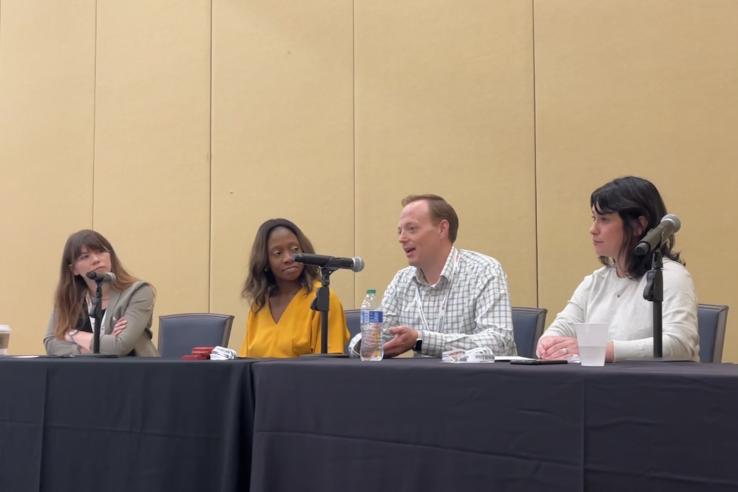
Building research partnerships between clinicians and economists: A recap from a 2023 ASHEcon panel

At the American Association of Health Economists 2023 Annual Conference (ASHEcon), J-PAL North America staff organized a roundtable discussion on building research partnerships between clinicians and economists. This panel featured researchers from two randomized evaluations that brought together health economists and medical professionals to conduct policy-relevant research: Dr. Jessica Cohen (Harvard T.H. Chan School of Public Health), a J-PAL affiliated researcher, alongside Drs. Mark Clapp and Fatima Cody Stanford (Harvard Medical School/Massachusetts General Hospital). Both featured projects were funded by the MIT Roybal Center for Translational Research, housed under J-PAL North America’s US Health Care Delivery Initiative.
The story behind the partnerships
The panel opened with the origin stories of these research partnerships. Jessica Cohen and Mark Clapp discussed their project “Bridging the Gap between Postpartum and Primary Care: Novel Approaches to Care Continuity for Women at High Risk for Chronic Disease,” where they are working together to evaluate how behavioral interventions can improve health outcomes for postpartum individuals.
Jessica highlighted the beginning of her collaboration with Mark:
“I was working on a passion project, which was about “advanced maternal age,” the delightful term that the American College of Obstetrics and Gynecology labels those of us who are pregnant and expected to deliver at age 35 or older...I had a baby before I was 35 and a baby after I was 35, and I noticed a very arbitrary guideline. I hadn't done a regression discontinuity design before, but this “age 35” guideline for advanced maternal age seemed like a good one. I quickly realized that I was in way over my head: what outcomes would you look at in this scenario? How does this label influence clinical decisions about testing or screening? So I asked some internal medicine doctors I knew about who conducted quasi-experimental work. Several people mentioned Mark, so I invited him to join the project and we collaborated on that regression discontinuity study. That evolved into many more collaborative projects including the randomized evaluation that we are conducting together.”
Fatima Cody Stanford discussed her project, “General and Tailored Covid-19 Health Messaging to Minorities in the United States,” with a team of economists and physicians. The multidisciplinary research team developed a series of videos aimed at increasing Covid-19 knowledge and spurring health information-seeking behaviors. This partnership began when Esther Duflo (MIT) and Marcella Alsan (Harvard Kennedy School), the economists on the project, approached Massachusetts General Hospital (MGH) to identify physicians.
“Esther and Marcella came to us at MGH’s Center for Diversity and Inclusion (CDI) to identify the best fit for the project. Together, we sat down and thought about what would be effective. We decided to record prompts where physicians of different racial and ethnic backgrounds would speak about things like masking, vaccination, and other topics to racial minority communities. I felt like Esther and Marcella coming to us, recognizing our expertise in healthcare complementing their expertise in behavioral messaging, was just the right marriage.”
Their study found that physician-delivered messaging effectively increased Covid-19 knowledge, information-seeking, and self-reported protective behaviors.
The importance of clinician-economist research teams
Cross-disciplinary collaborations can incorporate insights across economics, behavioral science, and medicine to develop impactful evaluations of innovative interventions.
Mark spoke about the fresh perspective economists can bring: “We as clinicians are in the trenches—we are seeing patients the way that we've been trained. Oftentimes, it can be hard to see beyond the patient in front of you or think more globally about how to improve care. Having someone with a fresh set of eyes and expertise in behavioral economics has been valuable in thinking about how to make the patient's experience and care better.”
These collaborations can facilitate research that is action-oriented and embedded within clinical practices, offering a quicker path to scaling up promising results, as Jessica highlighted: “One of the huge benefits of working with Mark is ensuring that we as economists are proposing an intervention that is feasible and fits into the health system. In addition to saving us a lot of time, effective approaches can actually be adopted.”
Fatima also spoke about how clinicians can support economists when interpreting critical health data, such as claims data: “On a typical day, I see 16-20 patients, and even from visit to visit for the same patient, my billing may look different. So when you want to pull claims data, the data may look like the doctor didn't treat a person for certain conditions. But if you do a deep dive, you may find they did get care. So, I think this collaboration is key, recognizing that we all have strengths and weaknesses, and neither is superior to the other— that there is a real synergy between the two groups.”
Advice for those interested in pursuing partnerships
The panelists ended the session by offering advice for others interested in pursuing similar partnerships, including:
- Identifying interested collaborators by scanning publications. For example, scanning the literature for physicians who are leveraging econometrics and economists doing research within health systems.
- Reaching out to department chairs for their knowledge of interested faculty members, as well as intentionally reaching out to centers of diversity, researchers of color, and younger researchers.
- Setting up expectations of authorship up front, as economists and clinical researchers have different approaches to this. Economists can learn more about publishing in a medical journal in this research resource.
Finally, the panelists called on funders to support this work in order to fund clinician time and catalyze the generation of high-quality, rigorous research that can be quickly translated into action.
If you are an economist interested in collaborating with a clinician or other medical professional (or vice versa), please reach out to the US Health Care Delivery Initiative team ([email protected]) or any of the listed panelists to learn more.
Related Content

Reflecting on the benefits of evaluating a health care delivery program: A recap from the HCDI @ 8 Convening

